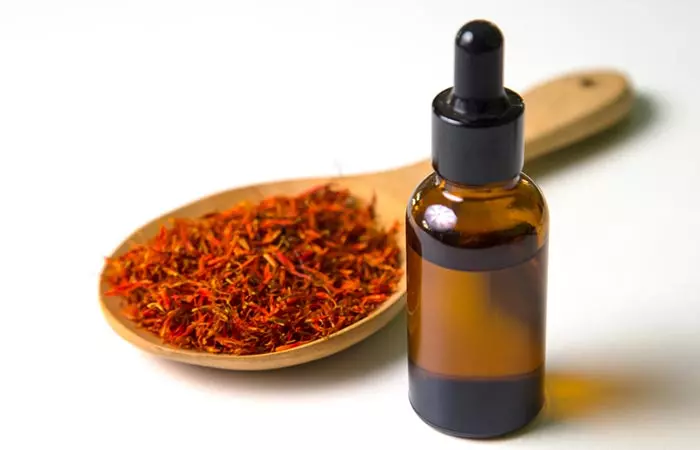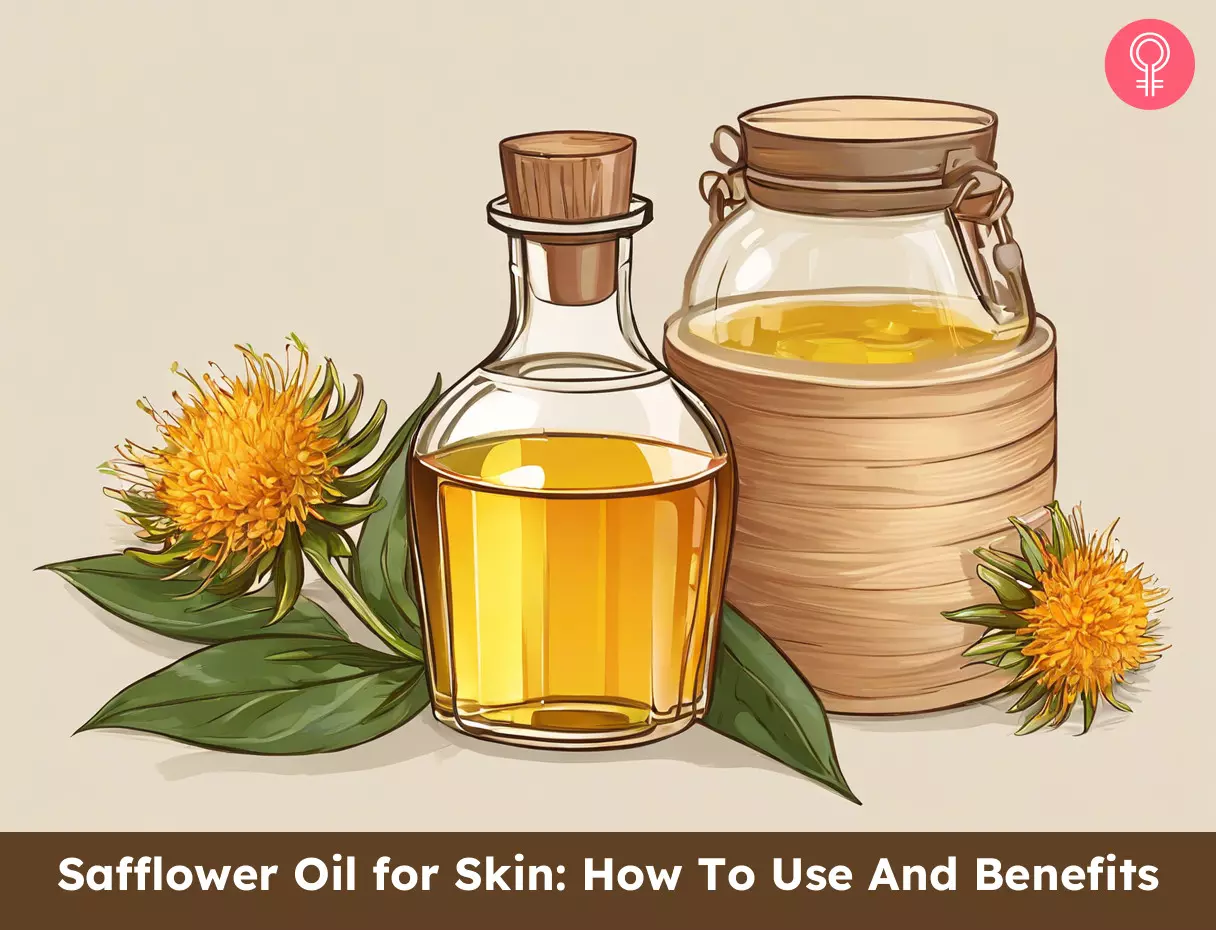What Are Its Benefits? It has anti-inflammatory and antimicrobial properties that can help with sebum production, skin texture, dark spots, and discoloration. Who Can Use It? It can be safely applied for moisturization, especially by people with sensitive skin. How Often? Products containing safflower oil can be used every day. Caution It may be mildly comedogenic, which can make some individuals allergic or sensitive to it.
Safflower oil has a rich linoleic acid content, making it good for the skin. Apart from that, it has many other benefits for the skin.
Benefits Of Safflower Oil For Skin
Treats Skin Disorders: Safflower oil is used to treat skin infections. It may also help reduce the risk of skin cancer (1). The oil may also help accelerate wound healing (2).
Has Antimicrobial Properties: The oil has good antioxidant, antibacterial, antifungal, and antimicrobial properties (2). It fights yeast, fungi, and bacteria that hinder wound healing.
Offers Nutritive Benefits: Safflower oil is often used in cosmetic products as an emollient (3). It is rich in oleic, linoleic, and omega-6 fatty acids (1). The high linoleic acid content improves skin appearance. It also keeps the skin from drying and flaking (3). Linoleic acid contains vitamins A, D, E, and K (3). Vitamin E helps improve skin health. Safflower oil helps treat essential fatty acid deficiencies and soothes irritated and abraded skin (3).
Helps Inhibit Melanin: Safflower seeds contain serotonin derivatives and acacetin that inhibit melanin formation and help improve skin complexion (1). This suggests it may help lighten dark circles, dark spots, and other skin discolorations.
Boosts Skin Hydration: Safflower oil moisturizes the skin and protects it. It boosts skin hydration and prevents water loss (4). The oil is also believed to regulate the skin barrier function.
Soothes Skin: The oil has anti-inflammatory properties that may protect the skin (5). It is used in cosmetic formulations to manage acne (1).
Has Antioxidant Properties: Safflower oil contains polyphenols, carotenoids, flavonoids, and chlorophylls that have high antioxidant properties (2). These antioxidant properties help fight oxidative damage and promote skin health. Research shows that creams containing safflower oil may prevent photodamage and reduce signs of skin aging (6). Reduces Inflammation: Safflower oil has anti-inflammatory and analgesic properties that help reduce inflammation. Applying safflower oil may help reduce pain and swelling, especially during the postoperative period. According to research conducted on rats, it was proved that a 300 mg/kg dose of safflower oil had similar pain relief effects to 10 mg/kg naproxen sodium in specific tests. It also helped reduce swelling in rats’ paws. This study suggests that safflower oil, especially at a specific dose, has potential as a natural pain reliever (7). Another study also confirms that the presence of vitamin E contributes to the anti-inflammatory activities of the oil (8).
These are the benefits safflower oil could have on your skin. That said, are you aware that safflower oil is available in two types?
Types Of Safflower Oil
Regular Safflower oil: This natural oil is thick in consistency and odorless. It is extracted from safflower seeds and may be used for cooking and cosmetic and medicinal purposes. It is safe to be applied to the skin. Regular safflower oil can be further classified into two types distinguished by the content of their unsaturated fatty acids.
Linoleic Safflower oil: This oil is rich in polyunsaturated fatty acids. It contains 68-79% of linoleic acid (3), (9). Due to its high content of linoleic acid, it is often used in skincare cosmetics too.
Oleic Safflower oil: This oil is rich in monounsaturated fatty acidsi Healthy dietary fats that keep your skin hydrated and healthy and slow down the signs of skin aging. . It is predominantly used as an edible oil in the food industry due to its lower saturated fat content.
Safflower Essential Oil: This oil is extracted from the petals of safflowers and pressed and distilled. It can be paired with other essential and carrier oils for enhanced skin care benefits. It cannot be ingested but only applied topically.
Here are some ways you can use safflower oil to benefit your skin.
How To Use Safflower Oil For Skin
1. Safflower Oil For Acne
Safflower oil has anti-inflammatory properties and is often used in the treatment of acne vulgaris and pimples. The oil also enhances wound healing and helps heal acne lesionsi Areas of skin that are different in size or color from the surrounding skin due to damage or injury to the skin. or scars. What You Need
Honey, 1 to 2 tablespoons Oatmeal, 1 to 2 tablespoons Safflower oil, 1 to 2 tablespoons
Procedure
2. Safflower Oil For Eczema
Eczema is an itchy skin inflammatory condition. It makes the skin barrier dysfunctional. According to the National Eczema Association, approximately 31.6 million individuals in the United States, accounting for 10.1% of the population, are affected by various forms of eczema. It is estimated that 1 in 10 people will develop this skin condition at some point in their lives, with the highest prevalence occurring during early childhood. Among adults with moderate to severe atopic dermatitis (AD), 60.5% reported experiencing severe or unbearable itch in the past two weeks. Additionally, 86% reported daily itching, while 63% reported itching for at least 12 hours each day. Its best treatment options include emollients and topical anti-inflammatory products (9). Safflower oil is known to improve the protective skin barrier function. It also has anti-inflammatory properties and prevents the skin from drying and flaking. What You Need
Safflower oil, a few drops, or as needed
Note: You can also pair safflower oil with essential oil. Procedure
3. Safflower Oil For Wrinkles
Safflower oil is known for improving skin texture and promoting skin cell renewal, thanks to its linoleic acid. Incorporating it into your beauty routine can help improve skin health and tone. The oil’s antioxidant properties help minimize the signs of aging, including wrinkles. What You Need
Safflower oil, a few drops, or as needed
Procedure
4. Safflower Oil For Dark Circles And Skin Lightening
Daily sun exposure, environmental damage, and other extrinsic factors constantly bombard the skin and affect its health. This damage appears as early signs of aging, dark circles, dark spots, discoloration, and photodamagei Changes in the skin like wrinkles and pigmentation that appear on the skin due to prolonged exposure to the UV rays of the sun. . Safflower oil can be used for melanin inhibition (1). It may help lighten the dark circles, dark spots, and other discolorations. What You Need
Safflower oil, a few drops
Procedure
5. Safflower Oil For Enhanced Skin Moisture
The non-greasy texture of safflower oil makes it an excellent skin moisturizing agent. It is similar to a humectant and helps maintain your skin’s moisture balance. What You Need
Safflower oil, a few drops
Procedure
Side Effects Of Safflower Oil
Safflower oil is used in many cosmetic products such as moisturizers and suntan lotions. It is generally considered to be safe and non-toxic. It is often used to treat abraded and irritated skin. However, a study conducted on animals showed that undiluted safflower oil may cause minimal skin irritation (3). Safflower oil also may be mildly comedogenici Any substance or product that may likely clog the pores on the skin and encourage the formation of blackheads. , which might irritate the skin. Therefore, a patch test should be done to check for any adverse or allergic reactions to the skin. Safflower is often mistaken for sunflower due to the similar sounding names. However, did you know that the benefits of sunflower oil also share similarities with safflower oil? Let us learn more in the following section.
Sunflower Oil Vs. Safflower Oil For Skin
When it comes to skincare, sunflower oil is relatively similar to safflower oil. They both contain high amounts of linoleic acid. They are also known to improve skin barrier function and are great emollients that improve skin health. However, safflower oil is not as well-known and researched as sunflower oil. It also has a lower content of saturated fat when compared to sunflower oil. What skin type is safflower oil good for? Safflower oil is light and non-greasy, and it suits all skin types. You can use it even if you have sensitive skin. Is safflower oil a moisturizer or a sealant? Safflower oil is an excellent moisturizer that gets absorbed quickly into the skin. Is safflower the same as saffron? No, safflower and saffron are not the same. However, many people use safflower as an alternative to saffron. What is the pH of safflower oil? Safflower oil is acidic and has a pH of 5.5 once digested.
Illustration: Safflower Oil for Skin: How To Use And Benefits
Unlock the natural potential of sunflower oil as a remedy for dry skin. Discover expert tips and techniques for nourishing and hydrating your skin using sunflower oil in this enlightening video below. So, go ahead and check it out now!












